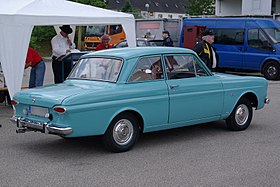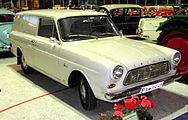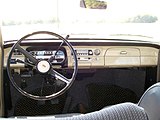Ford P4
| ford | |
|---|---|
|
Ford Taunus 12M (1965–1966)
|
|
| 12M (P4) | |
| Production period: | 1962-1966 |
| Class : | Middle class |
| Body versions : | Limousine , station wagon , panel van , coupé |
| Engines: |
Petrol engines : 1.2-1.5 liters (29.4-47.8 kW) |
| Length: | 4248-4322 mm |
| Width: | 1594 mm |
| Height: | 1458 mm |
| Wheelbase : | 2527 mm |
| Empty weight : | 860-930 kg |
| Previous model | Taunus 12M (G13 AL) |
| successor | Taunus 12M (P6) |
The Taunus 12M P4 (= Project 4, i.e. the fourth new passenger car design from the Ford factory in Cologne since the end of World War II ) was a mid-range car with a four-cylinder , four-stroke , V-engine that was manufactured from September 1962 to August 1966. The P4 was the first Ford to have front-wheel drive .
From September 1965 on the right front fender - still small and inconspicuous (see photo on the right, enlarged) - Down Again a manufacturer emblem, the so-called "Ford plum" attached to the Third Reich after Germany declared war on the United States by the Nazis banned was. The “12” in the type designation stood for the displacement - in deciliters - of the first version, the “M” for “masterpiece”.
Model history
General
The car was originally designed in the USA by Ford in Detroit under the name "Cardinal" as a competitor to the VW 1200 , which was very successful there at the time . After the development and reassessment of its market opportunities and costs in the USA, a production there was discarded and the design was transferred to the German Ford subsidiary. Before the P4 got its final shape, a few prototypes were produced in Cologne from 1960 . A comparable model, the Ford Cortina, was brought out in England, but it was based on an independent British development.
The only red taillights without separate indicators, the bowl-shaped steering wheel and the V-engine built in the USA remained visible hallmarks of the American origin . This V4 engine was later produced in various displacement variants and used in other vehicles, by Ford itself in the 17 m , Transit and Capri , but also since 1966 by Saab in the 96, initially as an alternative to the two-stroke engine and by Matra in the Matra 530 .
The P4 sold well in Germany for the short construction period of only four years. 680,206 P4 were produced.
technology
engine and gears
The four-cylinder V-engine with a cylinder bank angle of 60 ° was longitudinally installed in front of the front axle. As with other V-engines in cars ( SAS , Lancia ), each connecting rod had its own crank pin, that is, the triple-bearing crankshaft had four cranks that were offset by 120 or 60 ° so that the ignition interval was even. In this engine, cylinders one and three were on one side and two and four on the other, so they were counted as in an in- line engine and not bank-by-bank as in other V-engines, where two connecting rods act on a crank pin. With a stroke of 58.86 mm with a bore of 80 mm, the motor ( stroke ratio 0.74) was designed as a short-stroke . In order to reduce the inertia forces and moments and to achieve a smoother run, the engine had a balance shaft . Nevertheless, the smoothness was worse than that of comparable inline four-cylinder engines.
The choice of the engine concept was related to the front-wheel drive. An inline four-cylinder engine would have required an even longer front of the car and made the vehicle top-heavy.
A spur gear drive the balance shaft and camshaft . The gear on the crankshaft was made of steel, the gear on the camshaft and the balance shaft were made of fabric-reinforced phenolic resin ( Novotex ). The balance shaft also carried the V-belt pulley. The “central” camshaft, located above the crankshaft between the cylinder banks, actuated the parallel hanging valves via tappets , push rods and rocker arms . From September 1964, the color of the valve cover indicated the engine output: green = 40 hp, blue = 50 hp, red = 65 hp. The 55 hp version dropped out of the engine program.
A special technical feature was the cooling water circuit . Starting from the pump, it first reached the heating heat exchanger with an electric fan attached to the partition between the engine and the interior, from which the warm air was directed downwards when the heating was switched off and into the interior when the heating was switched on. As soon as a temperature of 80 ° C was reached, a thermostat switched the main cooler, through which only the airflow was flowing, into the circuit. The coolant did not need to be topped up. The circuit was not sealed, however, and the fluid had to be replaced every two years.
The power was transmitted to the front wheels via a single-disc dry clutch and a fully synchronized four-speed gearbox with steering wheel shift. Each drive shaft consisted of a hollow part coming from the gearbox with a simple universal joint, in which the part leading to the wheel could move axially for length compensation, protected by a sleeve. The advantage of the P4 was that neither the engine nor the transmission had to be removed when the clutch was repaired.
Chassis and body
In the first years of construction, the P4 had an idiosyncratic front axle design: the wishbones were attached to the engine-gearbox block, which thus fulfilled a load-bearing function. The transverse leaf spring at the top, on the other hand, was attached to a cross member with the floor assembly of the self-supporting body. Since the fall of 1964, the wishbones were hinged to the floor frame, which was extended to the front, and the engine was suspended elastically and largely vibration-free. Thanks to the front-wheel drive, the rigid rear axle, which was suspended from two leaf springs, could be held very easily, which enabled a relatively soft suspension. A disadvantage, however, turned out to be the strong body roll when cornering due to the weakly dimensioned anti-roll bars . To mitigate this, the P4 received stiffer shock absorbers in 1964 and the front leaf spring was supported at two points. At the same time, the rear stabilizer was omitted.
Disc brakes instead of drum brakes have been used on the front axle since model year 1965 .
There were two- and four-door sedans, a three-door station wagon which, in contrast to the station wagon versions of the other series, did not have the name "Tournament", and a coupe based on the two-door sedan with a shortened roof and a very sloping rear window. A stylistic feature of the bodywork was the horizontally running, tapering forward bead on the side parts, which ended in teardrop-shaped taillights. According to their American origin, the continuously red taillights each contained only one twin-filament lamp, with one filament serving as a taillight and the other alternately as a brake light and direction indicator (blinker). The electrical system had a voltage of 6 volts.
The coupe appeared in August 1963. It was equipped with the 55 hp engine and reached a top speed of 146 km / h. Despite a shorter roof and a height reduced by around 3 cm to 1424 mm, it offered a similarly large interior space as the sedan, but with 5 cm less headroom at the rear. In September 1964, the 55 hp engine was replaced by the 65 hp version. From April 1966, the coupé was also available with the 50 hp engine on request.
Record run
In 1963, a standard 12M set more than 100 world records on the Circuit de Miramas . Within 142 days, the car covered 356,273 kilometers at an average speed of 106.48 km / h ( Mistral company 300,000 ).
Technical specifications
| Parameter | 12M (1962) | 12M 1.5 l (1962) | 12M TS (1962) | 12M TS (1964) |
|---|---|---|---|---|
| Engine: | Four-cylinder four-stroke engine with balancer shaft ( V-engine with 60 degree bank angle ) |
|||
| Displacement: | 1183 cc | 1498 cc | 1498 cc | 1498 cc |
| Bore × stroke: | 80 x 58.9 mm | 90 x 58.9 mm | 90 x 58.9 mm | 90 x 58.9 mm |
| Performance at 1 / min: |
40 hp 4500 |
50 hp 4500 |
55 hp 4500 |
65 hp 4500 |
|
Maximum torque at 1 / min: |
78 Nm 2400 |
108 Nm 2400 |
108 Nm 2300 |
108 Nm 2300 |
| Compression: | 7.8: 1 | 8.0: 1 | 8.5: 1 | 9.0: 1 |
| Valve control: | central camshaft ( driven by spur gears ) | |||
| Cooling: | Water cooling with pump, thermostat and fan, frost-proof permanent filling (6.5 liters) |
|||
| Transmission: | fully synchronized 4-speed gearbox, steering wheel shift | |||
| Front suspension: | A triangular wishbone below, transverse leaf spring above, torsion bar stabilizer, telescopic shock absorber | |||
| Rear suspension: | Rigid axle on semi-elliptical longitudinal leaf springs, torsion bar stabilizer (until 1964), telescopic shock absorber | |||
| Steering: | Recirculating ball steering | |||
| Turning circle : | 11.5 meters | |||
| Electrical system: | 6 volts, direct current alternator with charge regulator | |||
| Body: | All-steel body, welded to the floor pan | |||
| Track width front / rear: | 1245/1245 mm | |||
| Wheelbase: | 2527 mm | |||
| Wheel size: | 5.60–13 (sedan and coupé), 5.90–13 (station wagon) | |||
| External dimensions L × W × H: | 4248 × 1594 × 1458 | 4248 × 1594 × 1458 | 4322 × 1594 × 1458 | 4322 × 1594 × 1458 |
|
Empty weight (without driver) *: |
860 kg | 860 kg | 870 kg | 870 kg |
| Top speed: | 123 km / h | 130 km / h | 139 km / h | 147 km / h |
- The station wagon weighed 930 kg.
Web links
- Ford 12M P4 PHOTOGRAPHY - Collection of images from P4 meetings, events and individual vehicles
- Ford 12M P4
- Ford Taunus M models
- Record run
Individual evidence
- ↑ The Ford Taunus 12m (P4), website of the Ford Oldtimer and Motorsport Club Cologne eV in the ADAC , accessed September 8, 2017.
- ↑ https://oldtim3r.de/wp-content/gallery/taunus-motor/EPSN0965.jpg picture of the crankshaft. The offset of the crank pins is 120 ° -60 ° -120 °
- ↑ On the technology of the utility vehicle by 1 liter displacement . In: Motor vehicle technology 1/1963, pp. 14-19.







